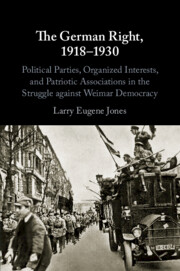 The German Right, 1918–1930
The German Right, 1918–1930 Book contents
- The German Right, 1918–1930
- The German Right, 1918–1930
- Copyright page
- Dedication
- Contents
- Figures
- Acknowledgments
- Abbreviations
- Introduction
- 1 Revolution and Realignment
- 2 Infrastructure of the German Right
- 3 Forging a Conservative Synthesis
- 4 Growth and Consolidation
- 5 The Radical Right
- 6 1923 – A Missed Opportunity?
- 7 From Triumph to Schism
- 8 Stabilization from the Right?
- 9 Paladins of the Right
- 10 A Resurgent Nationalism
- 11 The Road Back to Power
- 12 The Burden of Responsibility
- 13 From Defeat to Crisis
- 14 Reverberations and Realignment
- 15 The Chimera of Right-Wing Unity
- 16 Schism and Fragmentation
- 17 The Brüning Gambit
- 18 The September Earthquake
- Epilogue
- Select Bibliography
- Index
Epilogue
The Price of Disunity
Published online by Cambridge University Press: 21 March 2020
- The German Right, 1918–1930
- The German Right, 1918–1930
- Copyright page
- Dedication
- Contents
- Figures
- Acknowledgments
- Abbreviations
- Introduction
- 1 Revolution and Realignment
- 2 Infrastructure of the German Right
- 3 Forging a Conservative Synthesis
- 4 Growth and Consolidation
- 5 The Radical Right
- 6 1923 – A Missed Opportunity?
- 7 From Triumph to Schism
- 8 Stabilization from the Right?
- 9 Paladins of the Right
- 10 A Resurgent Nationalism
- 11 The Road Back to Power
- 12 The Burden of Responsibility
- 13 From Defeat to Crisis
- 14 Reverberations and Realignment
- 15 The Chimera of Right-Wing Unity
- 16 Schism and Fragmentation
- 17 The Brüning Gambit
- 18 The September Earthquake
- Epilogue
- Select Bibliography
- Index
Summary
The epilogue examines the implications of right-wing disunity upon the course of German political development from 1930 to 1933. The progressive disintegration of the DNVP from 1924 to 1930 left the non-Nazi German Right deeply divided and incapable of holding the more radical elements on the German Right that found a home in the NSDAP in check. This was a fact of German political life that became increasingly clear in the period from the September 1930 elections through the end of the Weimar Republic. The disunity and impotence of the traditional German Right left conservative strategists like Westarp, Schleicher, and Reusch with no alternative but to embrace the “taming strategy” as the best way of addressing Nazism and the threat that it posed to the status of Germany’s conservative elites. But the very success of this strategy presupposed the existence of a force capable of holding the NSDAP in check and in subjecting the Nazis to its own political agenda. The absence of such a force doomed the “taming strategy” to failure and greatly facilitated the Nazi seizure of power in 1932–33.
Keywords
- Type
- Chapter
- Information
- The German Right, 1918–1930Political Parties, Organized Interests, and Patriotic Associations in the Struggle against Weimar Democracy, pp. 589 - 597Publisher: Cambridge University PressPrint publication year: 2020
